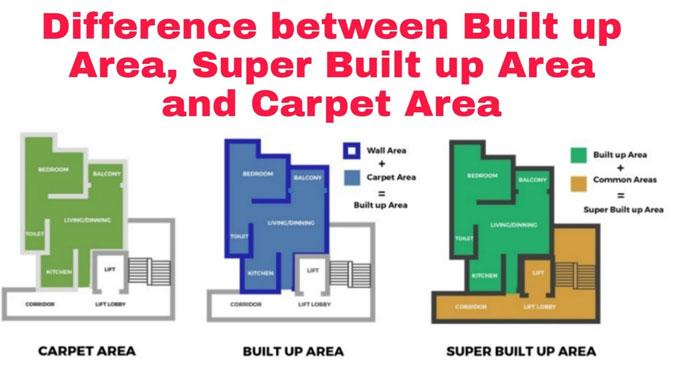
What are a plot, a built-up, and a carpet area, and what are their respective dimensions?
There are many terms used to describe different measurements related to real estate and property transactions. Areas of plots, built-up areas, and carpets are three key concepts in these discussions.
For buyers, sellers, and real estate professionals, having a thorough understanding of plot space, built-up area, and carpet area is essential. It enables people to take well-informed decisions, precisely assess property worth, and steer clear of ambiguities. Transparency and compliance in real estate transactions are further improved by taking into account variables affecting these measurements and comprehending regional variations.
Plot Area
The total area of land on which a building or other construction is situated is referred to as the plot area. It indicates the full area of land enclosing the property's limits. The plot area, which is commonly, expressed in square feet or square meters, serves as the foundation for determining the permitted floor area ratio (FAR), setbacks, and other zoning requirements, among other aspects of property development.
The maximum permitted constructed-up area, or the total amount that can be developed on the property, is determined in large part by the plot area. It's vital to remember that the plot area does not encompass the area the structure occupies. Rather, it stands for the open area that can be used for building, gardening, parking, or any other use allowed by municipal building codes.
Built-Up Area
The built-up area is the overall floor area that the building occupies, taking into account all enclosed spaces, walls, and communal areas. It includes all of the functional areas of the building, including the offices, apartments, lobbies, staircases, and other features. The exterior face of the outer walls or the centerline of the common walls is used to measure the built-up area.
The carpet area and wall thickness are both taken into account when calculating the built-up area. In addition to serving as the foundation for calculating the selling price, rental value, and calculating property taxes, it offers an accurate picture of the total amount of space that is available within the structure. It's vital to note that the built-up area calculation excludes building common areas like lifts, staircase and lobby areas.
Carpet Area
A property's actual usable space, excluding the thickness of the walls, is represented by the carpet area. It is the space where a carpet or furniture can be set up. In other terms, the carpet area relates to the usable floor space for the residents. Rooms, living spaces, kitchens, baths, and balconies, if applicable, are all included.
The most important factor for property buyers is the carpet area because it directly affects their living space. It is the space that is regarded as private property and is not utilized by any other residents. The true indicator of the actual space available to the tenants is the carpet area, which is measured from the interior face of the walls.
Importance of Sand as a Dwindling Resource
Importance of Understanding the Distinctions
Understanding the distinctions between plot space, built-up area, and carpet area is crucial for real estate professionals, purchasers, and sellers. Individuals can make educated decisions and prevent misunderstandings during real estate transactions by grasping these concepts. Buyers may evaluate the value for their money, analyze how much space is being used, and plan their interior designs accordingly by understanding the various measures.
For sellers, having thorough expertise in these areas enables them to give prospective buyers exact information and determine the right price. Real estate experts may also answer clients' questions, effectively interact with them, and help them make well-informed decisions.
Factors Affecting the Calculation of Built-Up and Carpet Areas
Calculating the built-up and carpet areas requires taking into account a variety of variables that could have an impact on the final measurements. A few significant aspects that affect these numbers include the thickness of the walls, the balconies, the common rooms, the utility ducts, the staircases, and the open terraces.
In the built-up area, wall thickness is typically taken into consideration, but not in the carpet area because it doesn't increase the amount of usable space. Balconies, on the other hand, may or may not be considered a portion of carpet area for determining built-up space, depending on regional laws and customs.
Since they are public spaces, common areas like lobbies and hallways are typically omitted from both the built-up and carpet areas. Additionally, stairways and utility ducts add to the total built-up area but are not included in the carpet area. In order to maintain openness and accuracy in real estate transactions, it is crucial to be aware of these elements and comprehend how they affect the final calculations.
Regional Variances and Legal Requirements
It is important to note that depending on local laws and regulations, the definitions and computations of plot area, built-up area, and carpet area may change. For these metrics, several nations or regions within a nation may have their own regulations and standards.
To maintain compliance and prevent legal complications, it is crucial for buyers, sellers, and real estate agents to be aware of the regional laws and ordinances governing property transactions.
For precisely measuring and designating these regions, some municipal authorities can also have special certification or documentation requirements. To ensure adherence to regional variations and legal requirements, it is advisable to consult local authorities or professionals who specialize in real estate transactions.
To get more details, watch the following video tutorial.
Video Source: Learn Civil Tech & Tricks
Wrapping it Up
Anyone dealing with real estate must be aware of the differences between plot area, built-up area, and carpet area. The built-up area determines the overall area occupied by a building, whereas the plot area establishes the framework for development. In the end, because it is their personal living space, the carpet area is the one that future homeowners appreciate the most.


